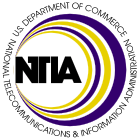- National Telecommunications and Information Administration
-
National Telecommunications and Information Administration 
Agency overview Formed 1978 Jurisdiction Herbert C. Hoover Building
1401 Constitution Avenue NW, Washington, D.C.Annual budget US$34 million (2009)
US$40 million (est. 2010)
US$46 million (est. 2011)Agency executive Lawrence E. Strickling, Assistant Secretary of Commerce Parent agency United States Department of Commerce Website [1] The National Telecommunications and Information Administration (NTIA) is an agency of the United States Department of Commerce that serves as the President's principal adviser on telecommunications policies pertaining to the United States' economic and technological advancement and to regulation of the telecommunications industry.
The NTIA administrator is Lawrence E. Strickling, Assistant Secretary of Commerce. He was confirmed by the United States Senate on June 25, 2009, following his nomination by President Barack Obama.
Among its stated goals are:
- Working to ensure that all Americans have affordable phone and cable TV service.
- Helping to bring the benefits of advanced telecommunications technologies to millions of Americans in rural and undeserved urban areas through its information infrastructure grants.
- Providing the hardware that enables public radio and television broadcasters to extend and maintain the reach of their programming.
- Advocating competition and liberalization of telecommunications policies around the world.
- Participating in international government-to-government negotiations to open markets for U.S. companies.
- Negotiating with foreign governments to ensure adequate spectrum for national defense, public safety, and U.S. business needs.
- Promoting efficient use of federal radio spectrum and encouraging the development and implementation of new and emerging telecommunications technologies.
- Performing long-term research to explore uses of higher frequency spectrum.
- Working with Federal, state, and local public safety agencies to address future spectrum requirements.
Contents
Main offices
1. The Office of Policy Analysis and Development (OPAD) is the domestic policy division of the NTIA.[1] OPAD is responsible for executing and managing research and analysis and preparing policy recommendations for the [{Executive_(government)|Executive Branch]]. The domestic policy office is responsible for creating policies that promote innovation and growth, both politically and economically, that provide for American businesses and consumers, alike.
The Associate Administrator is of the OPAD Daniel J. Weitzner.
These policies affect how Americans use and gain access to the wireless services like the Internet, telephone service and video programming. Issues the OPAD deals with include making sure all Americans have access to integrated broadband services, content is regulated to keep children safe on the Internet, competition in the telecommunication and information industries are cooperative and that users privacies are protected.
Additionally, OPAD carries out research, files reports, letters and formal comments, and proposes and respondes to federal legislation for the Federal Communications Commission (FCC) and other regulatory committees.
2. The Office of International Affairs (OIA) is responsible for developing and the implementation of policies to strengthen U.S. companies' ability to compete worldwide in both the Information Technology and Communications sectors.[2] In consultation with other U.S. agencies and the U.S. private sector, OIA partakes in both international and regional conferences and conventions to advocate for policies that open Information and communications technology (ICT) markets and boost competition.
The Associate Administrator for the OIA is Fiona Alexander.
The two main goals of the OIA are to:
- Formulate international ICT policy, gGoals, and strategies:
-
-
- By leveraging the knowledge of the Office of Spectrum Management, Office of Policy Analysis and Development, Office of Telecommunications and Information Applications, and the Institute for Telecommunications Sciences, the OIA can proved important policy and technical breakdown to the U.S. negotiators and interagency consignments.
- The OIA also provides long-lasting advice to the Executive Branch contemplating the management of the Internet’s domain name and numbering system (DNS), which is critical to the overall infrastructure.
-
- Advocate U.S. policy interests
-
- The goal of the OIA here is to: foster pro-competitive and flexible policy environments that:
-
- Carry the profits of ICTs to the global community
- Open up foreign market opportunities for U.S. Telecommunications and Information Technology companies
- Observe the esteemed role of all stakeholders in the production and facilitation of the Internet as well as telecommunications policy issues occurring in the ICT community
-
- The goal of the OIA here is to: foster pro-competitive and flexible policy environments that:
The OIA staff helps to participate in U.S. delegations of many different meetings in which global telecommunications and information policy is discussed and developed by providing the negotiators critical policy and expertise advice.
3. The Institute for Telecommunication Sciences (ITS) is the research and engineering laboratory of the NTIA.[3] ITS provides technical support to NTIA by further advancing telecommunications and information infrastructure development, strengthening domestic competition, enhancing U.S. telecommunications trade deals, as well as promoting a more effective use of the radio spectrum. Additionally, ITS serves as a key Federal appliance in investigating the current telecommunications’ challenges of other Federal agencies, state and local governments, private corporations and associations, and international organizations.The Director of Staff for the ITS is Al Vincent.
4. The Office of Telecommunications and Information Applications (OTIA) collaborates public and non-profit entities in productively using telecommunications and information technologies to complete national goals in addition to adequately providing public services.[4] The OTIA is also currently administering programs that are helping the nation's switch to digital television, the Broadband Technology Opportunity Program (BTOP), and Public Safety Interoperable Communications (PSIC) Grant Program.
The Associate Administrator of the OTIA is Bernadette McGuire-Rivera.
Additionally the OTIA is involved with the Public Telecommunications Facilities Program (PTFP), a competitive grant program that assists public broadcasting stations, state and local governments, Indian Tribes, and non-profit organizations construct facilities to bring educational and cultural programs to the American Public using telecommunication broadcast technologies.[5] Funds are allocated to support the Pan-Pacific Educational and Cultural Experiments by Satellite (PEACESAT) project, which provides satellite-delivered education, medical, and environmental emergency telecommunications to numerous small-island countries and territories in the Pacific Ocean area.[6]
The OTIA is also involved with The New York City 9/11 Program[7] and the Technology Opportunities Program (TOP).[8] The NYC 9/11 Program provided the Metropolitan Television Alliance (MTA) with $29.5 million for the creation and classification costs of the temporary digital television broadcast system in the NYC area until a more permanent facility is finished being constructed atop the Freedom Tower. The TOP program, which was last awarded grants in 2004, plays a significant role in understanding the vision of an information society by providing logical applications of innovative telecommunications and information technologies in both the public and non-profit sectors.
5. The NTIA's Office of Spectrum Management[9] is in charge of regulating use of spectrum allocated to the Federal Government. It serves in a manner equivalent to the Federal Communications Commission for this purpose. It is also the part of the Department of Commerce that oversees ICANN.
The Associate Administrator of the OSM is Karl Nebbia.
The OSM carries our the responsibilities of managing the radio frequency spectrum by:
-
-
- Establishing and issuing policy overlooking allocations and administrations governing the Federal spectrum use
- Assigning plans for both peacetime and wartime use of the spectrum
- Preparing for, participating in, and establishing the results of international radio conferences
- Maintaining spectrum use databases
- Participating in all aspects of the Federal Government’s communications regarding emergency readiness activities and automated information security systems
-
Broadband USA
In February 2009, the United States Congress passed the American Recovery and Reinvestment Act of 2009, which paved the way for a $7.2 billion grant given to the NTIA and U.S. Department of Agriculture's Rural Utilities Service to bolster broadband access across the United States. $4.7 billion of the grant was allocated to provide for the implementation of broadband infrastructure, develop and amplify public computer centers, encourage reasonable adoption of broadband service, and create and sustain a nationwide map of broadband proficiency and availability.
This project, known as the Broadband Technology Opportunities Program is being administered by the NTIA in three levels. The secondary purpose of this project is to reduce the digital gap between the various generation demographics.[10]
Comprehensive Community Infrastructure is the first of three projects in the BTOP. It aims to develop and unfold new or improved broadband internet facilities as well as to network with schools, libraries, hospitals, public safety facilities and other community anchor institutions.
The BTOP will also focus on Public Computer centers and will create new public computer facilities or enhance existing facilities that already offer broadband services to the general public or specific vulnerable populations.
The third project that the BTOP plans to address is Sustainable Broadband Adoption. This project will center in on increasing broadband internet usage, specifically in areas where broadband technology has been unavailable or underutilized. This includes digital literacy training and outreach campaigns to educate the general public on the importance and relevance of broadband in everyday life.
In 2009, the NTIA also launched the State Broadband Data and Development Program to carry out the missions of both the Recovery Act and the Broadband Data Improvement Act to establish an encompassing project that sustains the integration of broadband technology into the economy.[11]
Since the program commenced, NTIA allocated $293 million to 56 grantees, which include one from each state, five territories and the District of Columbia. Grantees are responsible for funding the creation, expansion and maintenance, as well as supporting and encouraging the use of, broadband technology. These efforts are made to aid small businesses and community institutions in the efficient and effective use of technology as well as to conduct research as to the boundaries in broadband expansion and innovation of broadband technology in the future.
National Broadband Map
These programs collected data used by the NTIA to refurbish a public interactive National Broadband Map that was released in February, 2011.[12] The map was authorized by Congress with the 2008 Broadband Data Improvement Act[13] and was funded through the 2009 economic stimulus bill.[14] The map will continue to be updated every six months with help from grantees and the general public.
The National Broadband Map is the foundation for efforts to expand and improve broadband internet access around the United States in under-equipped communities as well as assisting businesses and consumers to educate them on broadband internet options. The NTIA's findings show that while strides were made in broadband development and implementation, many people and institutions lack the broadband availability and capability needed for full internet engagement.[15] In the last year, broadband access in households has increased nearly five percent and the number of people not using the internet is down over three percent.. Yet, lower demographic groups continue to lack behind in internet capability.
The NTIA also found that many community anchor institutions are generally underserved in broadband connectivity. The data showed that two-thirds of the surveyed schools were signed up for broadband service that provide less than half the speed that educational technology studies recommend and only four percent of libraries subscribe to recommended broadband speeds.
Along with the continuous update of the National Broadband Map, the NTIA will sustain its state-driven efforts to increase broadband implementation and will move to expand its collaboration efforts to serve as an expansive network to empower broadband developers throughout execution of their development and creation phases.
References
- ^ About NTIA
- ^ NTIA: Office of International Affairs
- ^ The Institute for Telecommunication Sciences (ITS)
- ^ NTIA Office of Spectrum Management
- ^ PTFP Main Page
- ^ National Telecommunications & Information Administration
- ^ NTIA: Digital TV Transition and Public Safety
- ^ The Technology Opportunities Program
- ^ NTIA Office of Spectrum Management
- ^ About | BroadbandUSA - NTIA
- ^ State Broadband Initiative | BroadbandUSA - NTIA
- ^ NTIA, FCC Release National Broadband Map - Datamation
- ^ Broadband Data Improvement Act of 2008 | Benton Foundation
- ^ Stimulus Endgame: House and Senate OK Billions for Broadband - InternetNews
- ^ NTIA Unveils National Broadband Map and New Broadband Adoption Survey Results | NTIA
External links
- National Telecommunications and Information Administration official site
- NTIA's BTOP website
- NTIA's National Broadband Map
- National Telecommunications and Information Administration at WhoRunsGov at The Washington Post
Telecommunications (general) History Beacons · Broadcasting · Computer networks · Drums · Electrical telegraphy · Fax · Heliography · Hydraulic telegraphs · Internet · Mass media · Mobile phones · Optical telegraphy · Photophone · Radio · Radiotelephone · Satellite communications · Telegraphy · Telephones · Telephone patent controversies · Television · Undersea telegraph lines · Videophones
Pioneers Alexander Graham Bell · Alfred Vail · Alexander Popov · Charles Wheatstone · Claude Chappe · Edwin Armstrong · Elisha Gray · Guglielmo Marconi · Jagadish Bose · Johann Philipp Reis · John Logie Baird · Lee De Forest · Nikola Tesla · Philo Farnsworth · Reginald Fessenden · Tim Berners-Lee · Vint Cerf · Vladimir ZworykinMediums Coaxial cable · Free-space optical · Landlines · Optical fiber · Radio waves · Terrestrial microwaveNetworks Advanced Research Projects Agency · BITNET · Ethernet · FidoNet · ISDN · Internet · Local area · Mobile/Cellular · NGN · Packet switched · Public Switched Telephone · Radio · Television · Telex · Wide area · World Wide Web · WirelessGeographic Telecommunications in Europe Sovereign
states- Albania
- Andorra
- Armenia
- Austria
- Azerbaijan
- Belarus
- Belgium
- Bosnia and Herzegovina
- Bulgaria
- Croatia
- Cyprus
- Czech Republic
- Denmark
- Estonia
- Finland
- France
- Georgia
- Germany
- Greece
- Hungary
- Iceland
- Ireland
- Italy
- Kazakhstan
- Latvia
- Liechtenstein
- Lithuania
- Luxembourg
- Macedonia
- Malta
- Moldova
- Monaco
- Montenegro
- Netherlands
- Norway
- Poland
- Portugal
- Romania
- Russia
- San Marino
- Serbia
- Slovakia
- Slovenia
- Spain
- Sweden
- Switzerland
- Turkey
- Ukraine
- United Kingdom
- (England
- Northern Ireland
- Scotland
- Wales)
States with limited
recognition- Abkhazia
- Kosovo
- Nagorno-Karabakh
- Northern Cyprus
- South Ossetia
- Transnistria
Dependencies
and other territories- Åland
- Faroe Islands
- Gibraltar
- Guernsey
- Jan Mayen
- Jersey
- Isle of Man
- Svalbard
Other entities Telecommunications in North America Sovereign states Antigua and Barbuda · Bahamas · Barbados · Belize · Canada · Costa Rica · Cuba · Dominica · Dominican Republic · El Salvador · Grenada · Guatemala · Haiti · Honduras · Jamaica · Mexico · Nicaragua · Panama · Saint Kitts and Nevis · Saint Lucia · Saint Vincent and the Grenadines · Trinidad and Tobago · United States
Dependencies and
other territoriesAnguilla · Aruba · Bermuda · Bonaire · British Virgin Islands · Cayman Islands · Curaçao · Greenland · Guadeloupe · Martinique · Montserrat · Navassa Island · Puerto Rico · Saint Barthélemy · Saint Martin · Saint Pierre and Miquelon · Saba · Sint Eustatius · Sint Maarten · Turks and Caicos Islands · United States Virgin Islands
Telecommunications in South America Sovereign states Dependencies and
other territoriesTelecommunications in Oceania Sovereign states - Australia
- East Timor (Timor-Leste)
- Fiji
- Indonesia
- Kiribati
- Marshall Islands
- Federated States of Micronesia
- Nauru
- New Zealand
- Palau
- Papua New Guinea
- Samoa
- Solomon Islands
- Tonga
- Tuvalu
- Vanuatu
Dependencies and
other territories- American Samoa
- Christmas Island
- Cocos (Keeling) Islands
- Cook Islands
- Easter Island
- French Polynesia
- Guam
- Hawaii
- New Caledonia
- Niue
- Norfolk Island
- Northern Mariana Islands
- Pitcairn Islands
- Tokelau
- Wallis and Futuna
Telecommunications in Africa Sovereign
states- Algeria
- Angola
- Benin
- Botswana
- Burkina Faso
- Burundi
- Cameroon
- Cape Verde
- Central African Republic
- Chad
- Comoros
- Democratic Republic of the Congo
- Republic of the Congo
- Côte d'Ivoire (Ivory Coast)
- Djibouti
- Egypt
- Equatorial Guinea
- Eritrea
- Ethiopia
- Gabon
- The Gambia
- Ghana
- Guinea
- Guinea-Bissau
- Kenya
- Lesotho
- Liberia
- Libya
- Madagascar
- Malawi
- Mali
- Mauritania
- Mauritius
- Morocco
- Mozambique
- Namibia
- Niger
- Nigeria
- Rwanda
- São Tomé and Príncipe
- Senegal
- Seychelles
- Sierra Leone
- Somalia
- South Africa
- South Sudan
- Sudan
- Swaziland
- Tanzania
- Togo
- Tunisia
- Uganda
- Zambia
- Zimbabwe
States with limited
recognition- Sahrawi Arab Democratic Republic
- Somaliland
Dependencies and
other territories- Canary Islands / Ceuta / Melilla / Plazas de soberanía (Spain)
- Madeira (Portugal)
- Mayotte / Réunion (France)
- Saint Helena / Ascension Island / Tristan da Cunha (United Kingdom)
- Western Sahara
Telecommunications in Asia Sovereign
states- Afghanistan
- Armenia
- Azerbaijan
- Bahrain
- Bangladesh
- Bhutan
- Brunei
- Burma (Myanmar)
- Cambodia
- People's Republic of China
- Cyprus
- East Timor (Timor-Leste)
- Egypt
- Georgia
- India
- Indonesia
- Iran
- Iraq
- Israel
- Japan
- Jordan
- Kazakhstan
- North Korea
- South Korea
- Kuwait
- Kyrgyzstan
- Laos
- Lebanon
- Malaysia
- Maldives
- Mongolia
- Nepal
- Oman
- Pakistan
- Philippines
- Qatar
- Russia
- Saudi Arabia
- Singapore
- Sri Lanka
- Syria
- Tajikistan
- Thailand
- Turkey
- Turkmenistan
- United Arab Emirates
- Uzbekistan
- Vietnam
- Yemen
States with limited
recognition- Abkhazia
- Nagorno-Karabakh
- Northern Cyprus
- Palestine
- Republic of China (Taiwan)
- South Ossetia
Dependencies and
other territories- Christmas Island
- Cocos (Keeling) Islands
- Hong Kong
- Macau
Categories:- United States communications regulation
- United States Department of Commerce agencies
Wikimedia Foundation. 2010.


